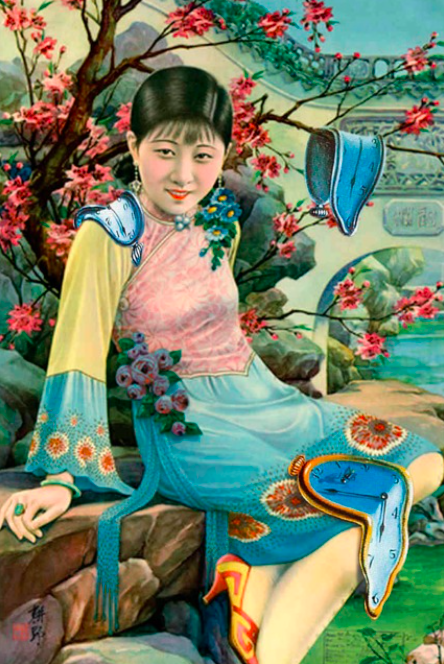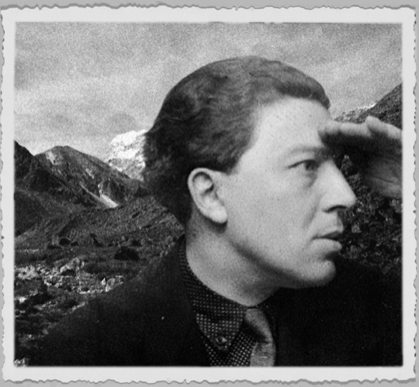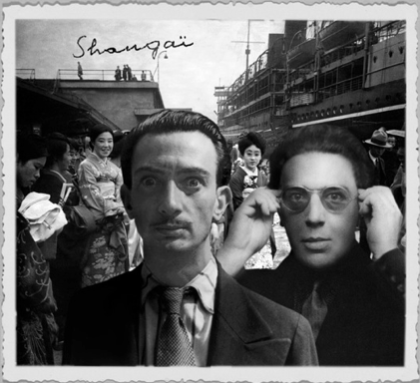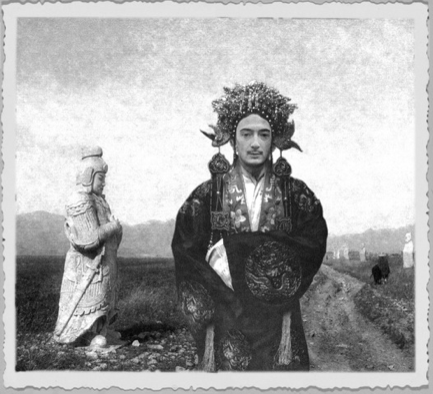Guy Girard
ANDRE BRETON IN CHINA
Illustrations by Pierre-André Sauvageot
Trans. Jason Abdelhadi

Salvador Dali, Portrait of Li Xiao-Tu with Soft Clocks, Gouache on rice paper, 24 x 14 cm, 1932, Location unknown.
THERE MIGHT HAVE BEEN A TIME…

André Breton at the China-Tibet Border, Photograph by Raymond Tchang.
In Paris I lived for a long time near a bridge beneath which flowed – not the Seine – but the Rue des Pyrénées. It was the Charles Renouvier Bridge, named in memory of a nineteenth-century French philosopher who, in addition to being a friend of Jules Lequier, founded Neo-Criticism. His theory is no longer a topic of much debate among civil society, doubtless to the great displeasure of our municipal council.
Shortly after moving near this uniquely arched construction, I was lucky enough to read a book by the eponymous author, who was at the time entirely unknown to me. Enigmatic title: Uchronia. And fascinating content. It proposed that given any single moment in history, that which follows from it is but one single sequence of events among many other possible outcomes. Everything might have been different according to different linkages of cause and effect which, for this or that reason (the sum of which no doubt affirm the role of Reason in History) did not occur – except, perhaps, for certain dreamers in the subjective domains of speculation and the imagination. We must try to understand history by unraveling from the fabric of its totality the weave of potentialities, which emerge as frequently from the adventures of our desire as from the permanence of certain myths. For the domain of Uchronia is a cousin to the domain Utopia. To venture out there isn’t useless – quite the contrary, if one is to understand the atemporality of the present, and what this latter derives from the primal dimension – the flux of becoming that Ernst Bloch called pre-appearance.
Accordingly, in his book, Renouvier imagines that a Roman Emperor might have thwarted the development of Christianity by means of good policy and judicious reforms, thereby preserving Latin civilization for several centuries. In The Man in the High Castle, Philip K Dick depicts the United States after WWII and the victory of the Axis, occupied by the Nazis and the Japanese. Against this somber image one might prefer to imagine along with Emile Pouget the victory of the revolutionary syndicalists in the France of the 1910s, establishing libertarian communism…
Taking into consideration not just the activities of organized groups or individuals in numerous countries affiliated with surrealism today, but also the mythic power of this emancipatory movement, unfinished and unachievable, I began to imagine bifurcations superimposed on that which we know about the history of surrealism – possible meanderings towards irrealized fields, which would no doubt also be magnetic. Playing with memory, adoptive daughter of the imagination: there are dates which function symbolically. Do we remember the date when André Breton returned from China?
ANDRE BRETON IN CHINA
“A manic wheel turns without thinking
It welcomes the guardian
Of fiery origins.”
Raymond Tchang
“It seems I must go to China around 1931 and while there run great dangers for twenty years,” wrote André Breton in his 1925 Letter to the Seers. In fact, it was in 1932 that Breton made this voyage, which only lasted a few months. The year had begun poorly for him. In March the split with Aragon affected him deeply, foreseeable as it was. In addition, the relations with the communist party was becoming more complicated. On the amorous plane, his relationship with Valentine Hugo was not in the least satisfying. Collective activity was often deceptive, with friends frequently absent – games with little pieces of paper that no longer amused anybody. To let it all go and hit the road? In August, vacationing with Dali at Cadaqués, Breton couldn’t hold out any longer. As for the soft-clock watchmaker, he was in an even worse state: his paintings weren’t selling and Gala, weary of their miserable life together, left him (for Paul Léautaud, if you’re curious).

Arrival of André Breton and Salvador Dali in Shanghai, Photograph by Raymond Tchang.
It was just then that Breton recalled the proposition of a trip to China that a young Chinese fellow had made to him with some insistence – a recent arrival to the group, Raymond Tchang. Alright then! He would take off for the orient – that orient which was as fascinating as ever for the surrealists. Deep inside, he was amused that, this time, he would at least not be heading for Lorient – the sinister Atlantic port where his parents had retired! Didn’t he discover – it was a sign! – that that Hervey-Saint Denys, whose Dreams and The Ways to Direct Them Breton so admired, was also a translator of Tang-era Chinese poetry? It was no small amount of trouble for Breton to procure this anthology, but it was a revelation for him to discover Li Bai, Wang Wei and those other distant poets from whom he detected such strange correspondences with surrealism – but who nevertheless appeared to him even more enigmatic than the seashell gaze of his beloved Papuan masks.
A telegram was sent off to Raymond Tchang who found Breton in Marseille a few days later– accompanied, surprise surprise, by Salvador Dali. They set off on a liner of the Maritimes Messageries company, called the Aurélia, and after three weeks of sailing disembarked at Shanghai.
Search all you want through the best books written on the surrealist adventure – you’ll learn nothing about Raymond Tchang except that he published two poems in 1934 in the special surrealist issue of the Belgian journal Documents. His real name was Tchang Jin-Fu. He chose the surname Raymond because of his admiration for Raymond Roussel, whose play The Dust of Suns he intended to produce in in his homeland. We suspect it was Tchang who incited the surrealists and other intellectuals to sign an open letter to the ambassador of China in 1931, denouncing the anti-communist repression enforced by the Kuomintang. The memory of this text (published by L’Humanité) was not without its worries for Breton as he handed over his passport to Chinese customs. Groundless fears! Raymond Tchang’s friends were already approaching them. Introductions made, Breton had in front of him Lu Xun, Ba Jin and Lao She. A young girl, acting as interpreter, also accompanied them. Named Li-Xiao-Tu, she was not long in becoming Dali’s latest girlfriend.
They stayed a few days in Shanghai, much preferring the old Chinese town to the European Bund. The travelers spent a longtime attempting to introduce their hosts to surrealism; animated discussions and debates began attracting young intellectuals, and the eventual creation of a native Chinese group was envisioned. More discreet meetings were even organized with communist militants (and thus held clandestinely). It would be otherwise little later on when, while visiting the city of Guangzhou, a similar meeting was cancelled for reasons of security. On that day, in the backroom of an opium den called The Blue Lotus, Breton and his companions might very well have met Mao Tsetung! Nevertheless the surrealists were not at times without their reservations. Even more than in Paris, they observed that the relations between these militant communists, their modes of thought and feeling, were muted by a central authority which seemed to them ever more unjustifiable. Breton promised to draw out all the conclusions, both theoretical and practical, once he got back to Paris. It was in that selfsame city that, while waiting for something that would trigger in him a more immediately poetic effusion, he discovered among a garden a collection of dream stones; he felt transported into one of Tanguy’s paintings. For his part, Dali believed himself to be again face to face with the delirious geology of the cliffs at Cape de Creus.
 Salvador Dali in costume for the Double Ninth Festival, Photograph by Li Xiao-Tu.
Salvador Dali in costume for the Double Ninth Festival, Photograph by Li Xiao-Tu.They then made for Szechuan, Tchang’s home province. From there they were supposed to circle-round to Beijing, as Dali absolutely had to see Coal Hill in the Forbidden City. But once they arrived at Chengdu, he discovered that, in the neighboring province of Yunnan (?), there existed a city which had the same name as he did. Notwithstanding the inevitable fatigue inherent in taking side-trips, it seemed imperative to him to set off for this place without delay, where he was expecting to encounter rhinoceroses made of fire, women-giraffes, and whatever else his paranoia-criticism could supply him in dipping into the best red pigments of the entire universe. But only Xiao-Tu went with him. The other two travelers washed their hands of such nominalist mania. Breton even remarked to the Catalan painter that he had never for his part felt a desire to wander along Cape Breton. Nonetheless, when they arrived at Dali, the young couple made due with the pleasure of each other’s company. Nothing would have troubled their idyll, were it not for an encounter in front of a sewing-machine store with an old man who sported long, curiously upward-pointing mustachios, sheltering himself from the sun with a children’s umbrella. He was barking orders at two other men on how to best arrange a ping-pong table in the middle of the very narrow street. Excited by this scene of concrete irrationality, Dali resolved to grow such mustachios himself, and in addition, to become an adept at ping-pong. Meanwhile, at Chengdu, chance so had it that Breton and Raymond Tchang were to meet Alexandra David-Néel. The surrealists were well apprised of her intriguing work and an honest sympathy was soon established between them. Almost immediately she undertook to teach them what she knew of Buddhism and Taoism and passionate discussions soon erupted between them on the affinities of certain oriental philosophies to surrealism. “From where does the sublime point emerge? From what void? Doesn’t the lotus, that blue flower of elective affinity, blossom from the mud?” “Certainly, but isn’t that mud already the soft and deliciously edible anamorphosis of Nirvana itself?” added Dali maliciously, accompanied by torrents of laughter from Xiao-Tu. They had rejoined them several days earlier and Breton was astonished at the newfound eccentricity of his friend, who trained every morning at table tennis with the local thugs. Together with Alexandra, they all went to visit some hermitages on Mount Emei to further plumb the depths of the questions at hand. There, she suddenly proposed that they accompany her on her next expedition to Tibet.
On the road, then, to the Land of Snows! Despite the hesitations of their guide, Dali imagined he would be able to procure instruction in certain tantric practices, and so postponed his desire to learn the mysteries of Beijing. After several weeks of rough-riding on the back of mule – it being already winter – they arrived at Lhasa. Alexandra David-Néel easily managed to secure an audience for her friends with the Dalai Lama. A properly outrageous reception: while Dali sketched the portrait of the Monk-King, the latter civilly thanked Breton for the Address which the Surrealist Group had sent him in the spring of 1925 and excused himself for not having yet sent back a reply. He added that he knew very well that they would be coming and that he was expecting in addition, around 1939, a visit to Potala from a certain Antonin Artaud…

Salvador Dali, Alexandra David-Néel and André Breton, In front of an automatist Lamasery, Photograph by Raymond Tchang.
The following days were quite fruitful, with many discoveries. But there were also a few disappointments. Breton sought in vain for the location of the legendary Agartha. The acquisition of some magnificent mandalas nevertheless provided him some solace. Dali wished to be initiated into tantrism, but it seemed unlikely that he would proceed far down that path. This mattered little to Xiao-Tu, who was satisfied to rib her lover on his mastery of vital breathing techniques. Meanwhile Breton was suffering from altitude sickness, Dali from the cold, and Xiao-Tu from the local food. Raymond Tchang for his part was developing a strong desire to take a dip in the sea. And so they repacked their bags and, by early spring 1933, had regained the Parisian cafes of the Place Blanche.
17 December 2012
 Salvador Dali at the Assault of Potala at Lhassa, Photograph by Raymond Tchang.
Salvador Dali at the Assault of Potala at Lhassa, Photograph by Raymond Tchang.
